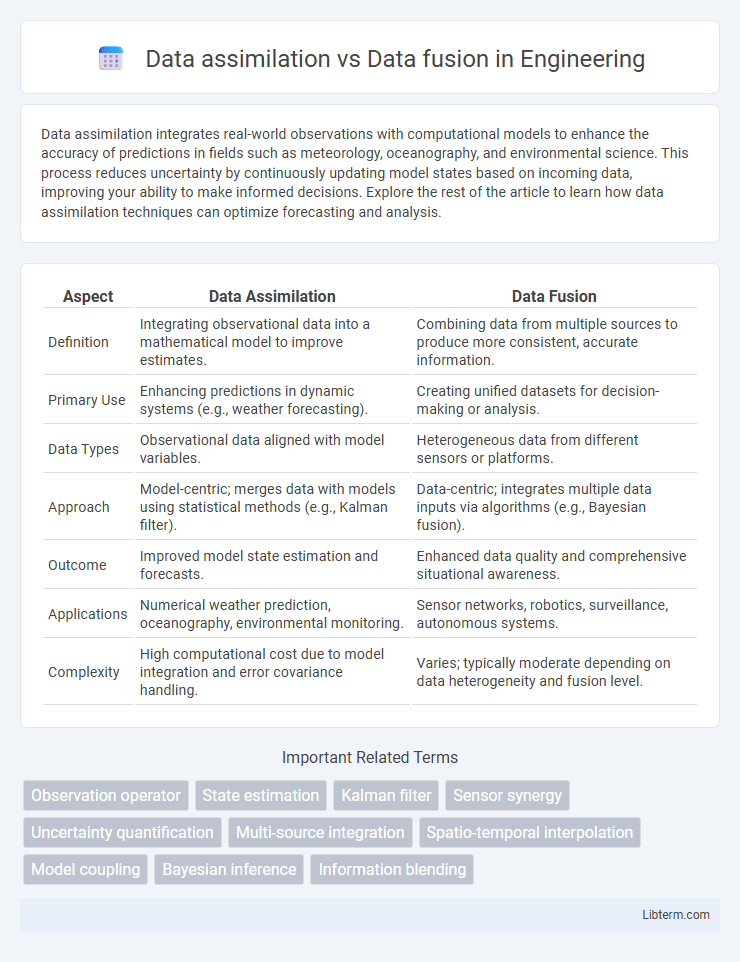Data assimilation integrates real-world observations with computational models to enhance the accuracy of predictions in fields such as meteorology, oceanography, and environmental science. This process reduces uncertainty by continuously updating model states based on incoming data, improving your ability to make informed decisions. Explore the rest of the article to learn how data assimilation techniques can optimize forecasting and analysis.
Table of Comparison
| Aspect | Data Assimilation | Data Fusion |
|---|---|---|
| Definition | Integrating observational data into a mathematical model to improve estimates. | Combining data from multiple sources to produce more consistent, accurate information. |
| Primary Use | Enhancing predictions in dynamic systems (e.g., weather forecasting). | Creating unified datasets for decision-making or analysis. |
| Data Types | Observational data aligned with model variables. | Heterogeneous data from different sensors or platforms. |
| Approach | Model-centric; merges data with models using statistical methods (e.g., Kalman filter). | Data-centric; integrates multiple data inputs via algorithms (e.g., Bayesian fusion). |
| Outcome | Improved model state estimation and forecasts. | Enhanced data quality and comprehensive situational awareness. |
| Applications | Numerical weather prediction, oceanography, environmental monitoring. | Sensor networks, robotics, surveillance, autonomous systems. |
| Complexity | High computational cost due to model integration and error covariance handling. | Varies; typically moderate depending on data heterogeneity and fusion level. |
Introduction to Data Assimilation and Data Fusion
Data assimilation integrates real-time observational data into computational models to improve the accuracy of predictions in fields such as meteorology and oceanography. Data fusion combines data from multiple sources or sensors to produce more consistent, accurate, and useful information than individual data sets alone. Both techniques enhance decision-making by optimizing data reliability and completeness in complex systems.
Core Concepts and Definitions
Data assimilation integrates observational data into computational models to improve accuracy by minimizing discrepancies between model predictions and real-world measurements, often using techniques like Kalman filtering and variational methods. Data fusion combines data from multiple heterogeneous sources or sensors to create a more comprehensive and reliable representation of an environment or phenomenon, emphasizing the complementary strengths of each data set. Core to data assimilation is the dynamic updating of model states over time, while data fusion centers on merging static or streaming data to enhance situational awareness or decision-making.
Historical Background and Evolution
Data assimilation originated in meteorology during the 1960s to improve weather forecasts by integrating observational data with numerical models, leveraging Kalman filtering techniques from control theory. Data fusion emerged earlier in the 1950s within military applications to combine multisensor information for enhanced situational awareness. Both fields have evolved through interdisciplinary advances, with data assimilation expanding into oceanography and environmental science, while data fusion broadened into robotics, computer vision, and complex sensor networks.
Key Objectives and Applications
Data assimilation aims to integrate observational data into computational models to improve state estimation and forecast accuracy, primarily utilized in meteorology, oceanography, and environmental sciences. Data fusion focuses on combining data from multiple heterogeneous sources to achieve more consistent, accurate, and useful information, with key applications in sensor networks, robotics, and surveillance systems. Both techniques enhance decision-making by leveraging complementary strengths: data assimilation refines dynamic model predictions, while data fusion synthesizes multi-source data for comprehensive situational awareness.
Techniques in Data Assimilation
Data assimilation techniques, such as Kalman filtering, variational methods, and ensemble-based approaches, integrate observational data with model predictions to improve accuracy and reduce uncertainty in dynamic systems. These methods optimize state estimation by minimizing discrepancies between model outputs and real-time observations, effectively enhancing forecasting performance. In contrast, data fusion combines heterogeneous data sources at different levels, emphasizing integration rather than iterative model correction.
Techniques in Data Fusion
Data fusion techniques include Bayesian inference, Kalman filtering, and Dempster-Shafer theory, enabling the integration of heterogeneous data sources for enhanced decision-making. Unlike data assimilation, which primarily updates model states using observational data, data fusion combines multiple sensor inputs to create a unified, comprehensive representation. Advanced methods such as deep learning-based fusion and evidence theory improve accuracy and robustness in multisensor environments.
Comparative Analysis: Methodologies and Approaches
Data assimilation integrates observational data into dynamic models using techniques such as Kalman filtering and variational methods to improve model accuracy in real-time, emphasizing temporal consistency. Data fusion combines heterogeneous data sources at multiple levels--sensor, feature, or decision--to enhance information reliability and completeness, often employing machine learning and statistical inference. Comparative methodologies highlight data assimilation's reliance on physical model constraints and uncertainty quantification, whereas data fusion prioritizes multi-source integration and pattern extraction for comprehensive situational awareness.
Advantages and Limitations
Data assimilation integrates observational data into computational models to improve prediction accuracy, offering significant advantages in real-time weather forecasting and environmental modeling due to its statistical rigor and model consistency. Data fusion combines multisource data to create a comprehensive representation, enhancing robustness and completeness, particularly in sensor networks and multimedia applications. While data assimilation is limited by model dependency and computational intensity, data fusion faces challenges in handling heterogeneous data formats and resolving conflicting information.
Real-World Use Cases and Industry Applications
Data assimilation integrates observational data into numerical models to improve accuracy in fields like weather forecasting and oceanography, enhancing predictive capabilities by continuously updating model states. Data fusion combines data from multiple heterogeneous sources, such as sensors and databases, to generate comprehensive, actionable insights in industries like autonomous vehicles, healthcare, and defense systems. Real-world applications of data assimilation emphasize dynamic system modeling and forecasting, while data fusion supports decision-making through multi-source information integration.
Future Trends and Research Directions
Emerging trends in data assimilation emphasize adaptive algorithms and real-time processing to enhance predictive accuracy in dynamic systems such as meteorology and oceanography. Data fusion research is increasingly integrating deep learning and heterogeneous sensor networks to improve robustness and contextual understanding in autonomous systems and IoT applications. Future directions include hybrid frameworks combining assimilation and fusion techniques to leverage synergies in spatiotemporal data integration and uncertainty quantification.
Data assimilation Infographic

 libterm.com
libterm.com